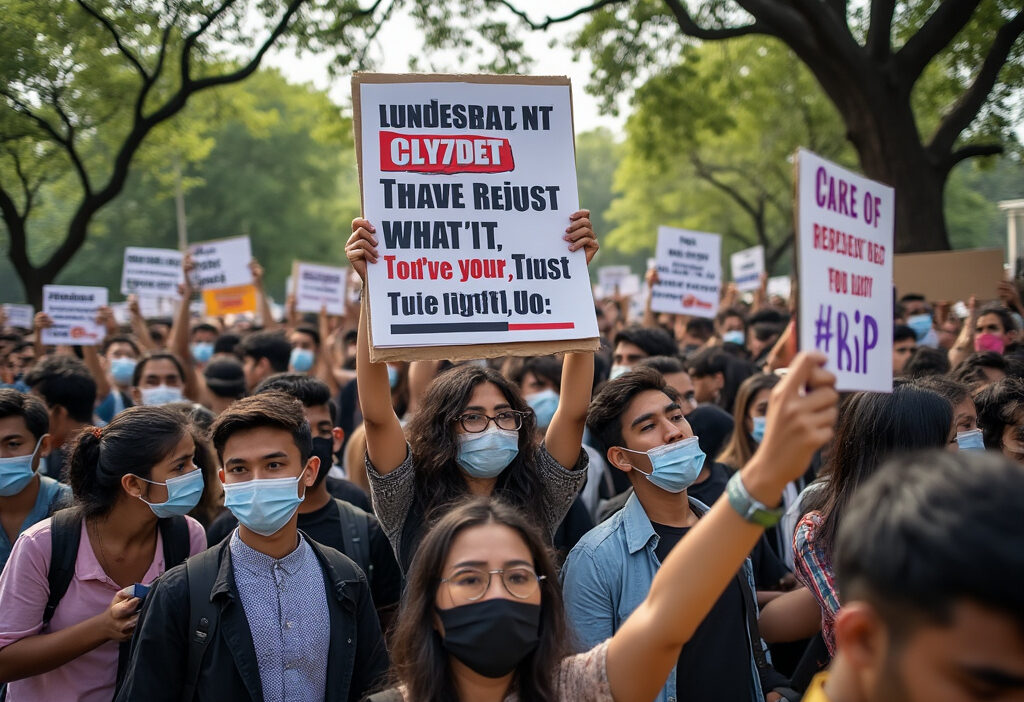Hyderabad Central University Protest A Deep Dive into the Student Movement
The Hyderabad Central University protest marks a significant chapter in India’s student activism history, highlighting issues of social justice, education rights, and institutional accountability. This article delves into the origins, key events, and outcomes of the protest, offering a comprehensive understanding of its impact on the university and beyond. Through detailed analysis, we explore the voices that shaped this movement and its lasting implications.
The Genesis of the Protest
The protests at Hyderabad Central University (HCU) in 2015-16 were ignited by a combination of institutional neglect and systemic discrimination against marginalized students, particularly Dalits and other oppressed castes. The immediate trigger was the suspension of Rohith Vemula, a Dalit PhD scholar, and four other students from the Ambedkar Students’ Association (ASA) for allegedly assaulting an ABVP member—a charge widely seen as politically motivated. The university administration’s swift punitive action, without proper investigation, exposed deep-seated biases in disciplinary processes.
Social factors played a crucial role. HCU, like many Indian universities, had long struggled with caste-based exclusion, where Dalit students faced isolation, inadequate mentorship, and financial hurdles. The protest gained momentum as students highlighted how institutional mechanisms—such as the Executive Council—often reinforced upper-caste dominance. The suicide of Rohith Vemula in January 2016 became a turning point, transforming the protest into a nationwide movement against caste oppression in academia.
The ASA’s resistance was not just about Rohith’s case but also against systemic erasure of Dalit voices in education. Their demands included accountability from the administration and reforms to ensure equitable treatment for marginalized students. The protest’s genesis thus lay in both immediate injustice and decades of structural inequality.
Key Figures and Voices
The Hyderabad Central University (HCU) protest was galvanized by key figures whose voices resonated deeply within and beyond the university. Among them, Rohith Vemula, a Dalit PhD scholar, became the symbolic face of the movement after his tragic suicide in 2016. His poignant suicide letter, which highlighted systemic caste discrimination, became a rallying cry for students nationwide. The Ambedkar Students’ Association (ASA), a prominent Dalit student group, played a pivotal role in organizing protests, framing the struggle as a fight against institutional casteism.
Other influential figures included Kanimozhi Karunanidhi, a parliamentarian who voiced solidarity, and Jignesh Mevani, an activist who linked HCU’s protests to broader Dalit rights movements. Faculty members like Professor K. Laxminarayana also supported the students, criticizing the administration’s apathy.
The protesters’ demands centered on justice for Rohith, accountability for university officials, and systemic reforms to address caste-based marginalization. Their messaging emphasized social justice, academic freedom, and institutional equality, resonating with marginalized communities across India. These voices transformed HCU into a microcosm of larger societal struggles, ensuring the protest’s legacy endured far beyond the campus.
The Role of Social Media
The Hyderabad Central University protests gained unprecedented momentum due to the strategic use of social media, which became a critical tool for mobilization, awareness, and countering mainstream narratives. Platforms like Twitter, Facebook, and WhatsApp allowed students to bypass traditional media blackouts, sharing real-time updates, videos, and testimonies that exposed police brutality and institutional apathy. Hashtags like #JusticeForRohith and #HCUProtest trended nationally, drawing attention from activists, politicians, and international observers.
Social media also enabled decentralized coordination, with students organizing sit-ins, rallies, and solidarity events across campuses. Live streams and viral posts humanized the protesters, shifting public perception in their favor. However, it also amplified disinformation, with opposing factions spreading manipulated content to discredit the movement. Despite this, the digital campaign forced authorities to acknowledge the protests, as online pressure translated into offline scrutiny.
The role of social media extended beyond logistics—it became a space for dissent, where marginalized voices could challenge dominant power structures. Its impact was twofold: it globalized the movement while exposing the vulnerabilities of digital activism in an era of surveillance and censorship.
Government and Institutional Response
The Hyderabad Central University protests triggered a complex response from both the university administration and government bodies. Initially, the university administration was criticized for its heavy-handed approach, including the suspension of students and disciplinary actions that many saw as punitive rather than restorative. The government, particularly the Ministry of Human Resource Development, faced backlash for its perceived inaction and delayed intervention, which further escalated tensions.
As protests intensified, the administration attempted to engage in dialogue, forming committees to address grievances. However, students viewed these measures as tokenistic, citing a lack of tangible outcomes. The government eventually intervened, with political leaders issuing statements—some condemning the protests, others expressing solidarity. The police presence on campus became a flashpoint, with allegations of excessive force and arbitrary detentions.
Institutional responses were marked by contradictions. While some officials advocated for reconciliation, others doubled down on disciplinary measures. The protests exposed systemic failures in addressing caste-based discrimination, forcing the administration to revisit policies. Yet, the slow pace of reform left many disillusioned, fueling further activism. These reactions set the stage for broader national and international scrutiny, as covered in the next chapter.
National and International Reactions
The Hyderabad Central University protests resonated far beyond the campus, drawing reactions from national and international stakeholders. Student unions across India, including Jawaharlal Nehru University (JNU) and Delhi University, organized solidarity marches, framing the protest as a fight against caste discrimination and authoritarianism. Political parties were sharply divided—left-wing groups condemned the administration’s handling of the crisis, while right-wing factions dismissed the protests as politically motivated. The United Nations Human Rights Council expressed concern over the use of force against students, amplifying global scrutiny.
Internationally, universities like Oxford and Harvard hosted discussions on academic freedom and caste oppression, linking the protests to broader struggles against systemic inequality. Human rights organizations, including Amnesty International, documented alleged violations, urging accountability. Conversely, some critics abroad dismissed the movement as localized unrest, downplaying its significance.
The protests also sparked debates in Indian diaspora communities, with rallies held in the US, UK, and Canada. Social media became a battleground, with hashtags like #JusticeForHCU trending globally. While the administration’s response was covered in the previous chapter, this external solidarity underscored the protest’s symbolic weight, setting the stage for its enduring influence on student activism, as explored next.
The Impact on Student Activism
The Hyderabad Central University protest became a turning point for student activism in India, galvanizing a new wave of resistance against systemic discrimination and state repression. The movement’s emphasis on social justice and institutional accountability resonated deeply with students nationwide, inspiring similar protests at Jawaharlal Nehru University, Delhi University, and beyond. The unity displayed by marginalized communities—particularly Dalit and minority students—set a precedent for intersectional solidarity in campus struggles.
Beyond India, the protest drew attention from global student movements, with solidarity demonstrations in universities across the U.S. and Europe. The use of social media as a tool for mobilization became a blueprint for future activism, enabling decentralized organizing and amplifying marginalized voices. The protest also exposed the vulnerabilities of student movements, as state crackdowns and media vilification tested their resilience.
The legacy of Hyderabad Central University’s protest endures in the tactics and discourses adopted by contemporary movements, from fee hikes to caste-based discrimination. It reinforced the idea that campuses are not just educational spaces but sites of political resistance, shaping a generation of activists committed to systemic change.
Legal and Policy Changes
The Hyderabad Central University (HCU) protests triggered significant legal and policy reforms at both institutional and national levels, addressing systemic discrimination and student welfare. Within the university, the administration introduced mandatory diversity and inclusion training for faculty and staff, aiming to curb caste-based biases in academic environments. The revised grievance redressal mechanism was strengthened to ensure faster resolution of student complaints, with external oversight to prevent administrative apathy.
At the national level, the protests reignited debates on caste discrimination in higher education, leading to the expansion of the Rohith Act—a proposed anti-discrimination law named after Rohith Vemula. While the act remains pending, the protests pressured the University Grants Commission (UGC) to issue stricter guidelines preventing caste-based exclusion in federally funded institutions. Additionally, the SC/ST Prevention of Atrocities Act saw renewed enforcement, with universities mandated to report discrimination cases promptly.
The protests also influenced policy discussions on mental health support for marginalized students, prompting HCU and other universities to establish dedicated counseling services. These reforms, though incremental, reflect the movement’s lasting impact on institutional accountability and social justice frameworks in Indian academia.
Personal Stories from the Frontlines
The Hyderabad Central University protest was not just a political moment—it was deeply personal for those who lived through it. Students and faculty who stood on the frontlines carry stories of resilience, fear, and solidarity. One student recounted how the protest transformed from a demand for justice into a fight for dignity, describing nights spent huddled in tents, singing songs of resistance to keep spirits high. Another spoke of the chilling moment when police entered campus, recalling the deafening silence that followed the crackdown, broken only by whispers of reassurance among peers.
Faculty members, too, shared their struggles—balancing their roles as educators and allies. A professor admitted feeling torn between institutional pressure and moral duty, ultimately choosing to stand with students despite professional risks. For many, the protest was a turning point, reshaping their understanding of caste, power, and resistance.
The emotional toll was immense. A research scholar revealed how the trauma lingered long after the protests ended, manifesting in sleepless nights and anxiety. Yet, amid the pain, there was hope. Stories of shared meals, impromptu poetry sessions, and strangers becoming family highlighted the protest’s unifying power. These personal narratives humanize the movement, ensuring its legacy lives beyond policy changes and legal battles.
The Cultural Impact
The Hyderabad Central University protest transcended its immediate political context to become a powerful cultural symbol, inspiring artists, writers, and filmmakers to engage with its themes of resistance and marginalization. The protest’s imagery—particularly the iconic photos of students raising fists under the university’s arches—has been reproduced in murals, posters, and digital art, transforming it into a visual shorthand for dissent. Writers and poets, including those from Dalit and marginalized communities, have woven the protest into their works, using it as a lens to explore systemic oppression. Poets like Meena Kandasamy and Chandramohan Sathyanathan have penned verses that echo the voices of the protesters, blending personal anguish with collective defiance.
In cinema and documentaries, the protest has been framed as a turning point in India’s student movement. Films like Rohith Vemula: The Unfinished Portrait and plays staged by activist theater groups have kept the narrative alive, ensuring its resonance beyond academia. Social media, too, played a pivotal role, with hashtags like #JusticeForRohith amplifying the movement’s reach. The protest’s cultural legacy lies in its ability to stitch itself into the fabric of contemporary resistance art, reminding society of the cost of silence and the power of collective voice.
Looking Forward The Path Ahead
The Hyderabad Central University protests have left an indelible mark on student activism and social justice movements in India, setting a precedent for future struggles. As the dust settles, the question remains: what lies ahead? The protests have amplified demands for institutional accountability, caste equity, and democratic rights within universities, forcing administrations to reckon with systemic biases. Moving forward, Hyderabad Central University may see structural reforms, but the challenge lies in ensuring these changes are substantive rather than symbolic.
Student movements across India have drawn inspiration from HCU, adopting its strategies of solidarity and resistance. The protest’s legacy could fuel a broader wave of activism, particularly among marginalized communities fighting for representation and dignity. However, the state’s increasing crackdown on dissent raises concerns about the shrinking space for student voices. The use of sedition laws and punitive measures against protesters underscores the need for legal safeguards to protect academic freedom.
Technologically, the protest has demonstrated the power of digital mobilization, with social media becoming a critical tool for organizing and amplifying dissent. Future movements may leverage these platforms even more strategically, though surveillance and censorship pose growing threats. The HCU protest has not just shaped campus politics—it has redefined the fight for social justice in India, leaving a roadmap for future generations to follow.

Conclusions
The Hyderabad Central University protest serves as a poignant reminder of the power of collective action in addressing systemic inequalities. From its roots in social injustice to its nationwide repercussions, the movement has left an indelible mark on India’s educational and political landscape. As we reflect on its legacy, the protest underscores the ongoing struggle for equity and justice in higher education.



